Do you ever notice your lips tasting like salt, or feel grainy salt crystals on your face after hiking in hot weather? Maybe your eyes burn as the sweat drips off your eyelids. Those are electrolytes – what is left when the water component of sweat evaporates. They need to be replenished by drink and diet.
An electrolyte imbalance is a primary contributor to muscle cramping and fatigue during heavy activity, such as backpacking or hiking. Loss of water through sweat or elimination is what causes an electrolyte imbalance. If you do not consume enough minerals from food or fluids, muscle cramping and heart palpitations can result. If you drink too much water, it can flush out electrolytes from your body. Your body tries to maintain the proper electrolyte balance, but it can not do so if the minerals are not replenished correctly through diet.

What are electrolytes?
Electrolytes are electricity-conducting ions or salts. Electrolytes consist of more than just standard sodium chloride (table salt). Specifically, electrolytes are positive ions of sodium, potassium, calcium, magnesium, and negative ions of chloride, bicarbonate, sulfate, and phosphate. The ion charge provides the voltage for the blood cells to move around the body and perform their functions. Electrolytes are essential because they allow the cells in our bodies to function properly and maintain our energy and stability.
Replacing Electrolytes
The loss of excessive amounts of electrolytes and water can quickly dehydrate you. For obvious reasons, fluid intake should always remain in excess of sweat loss. Water is vital for digestion and metabolic waste. And electrolytes are essential for the body to retain water. You can prevent dehydration by staying hydrated, but water alone is not enough to regain electrolyte balance. You also need to consume foods high in electrolytes. Sodium and Potassium are the primary electrolytes lost through exercise. Follow these steps to replenish sodium and potassium requirements in your diet –
 1. Do not restrict salt intake in your food
1. Do not restrict salt intake in your food
The guideline for healthy adults is to consume about 1 tsp per day, which is about 2300 mg to replace the amount lost daily through sweat.
2. Incorporate foods containing potassium in your diet
Potassium-rich food sources come from a wide variety of fruits & vegetables –
Fruits such as bananas, dates, raisins, papaya, coconut, avocado, and apricots are high in potassium. These are excellent to eat when dried – except for avocado; the high oil content makes it tricky to dry without significantly altering the flavor. Instead, pack fresh avocado – the calorie-load is worth the weight, and they’ll survive for several days if packed with care (keep cushioned or on top of your pack). Avocados are a fantastic high-calorie treat in the wilderness loaded in healthy fat. Pair with sprouts & olive oil for a tortilla sandwich.
Vegetable sources such as potatoes, spinach, lentils, beans (soybean, pinto, white, kidney, lima).
- Dehydrated potato-based meals or meals containing dried spinach can be found easily;
- Beans add a lot of protein, fiber, flavor, and substance to dishes; look for dehydrated or instant beans, lentils, or bean flakes instead of dried beans which are uncooked;
- Dried soybeans (edamame) is difficult to find; soy is more commonly found in energy bars, non-dairy milk powder, energy drinks, or can be purchased dried in the form of TVP (textured vegetable protein), although we advise against consuming TVP as it is a highly processed low-quality food; better soy-based foods are tofu and tempeh although dried tofu and tempeh are challenging to find.
3. Stay hydrated by drinking water throughout the day, regardless of your thirst
The clothing typically worn for outdoor activity is designed to wick away moisture from the skin allowing it to dry fast. Wicking clothing is great for comfort, but it does make it difficult to gauge how much sweat we’ve lost. The burning sensation of salty sweat dripping into your eyes or the taste of salt on your lips is a sure signal that you are losing liquids and salts when it is hot outside. However, you probably don’t notice the amount of sweat lost when the temperature drops, or it is windy. No matter what the temperature outside, keep drinking throughout the day to stay hydrated — even if you don’t feel thirsty. Your body works more efficiently (including heating and cooling) when adequately hydrated.
Outdoor Herbivore’s high potassium meals:
- Toasted Sunburst Muesli – mixed grain cereal with instant soy milk, dates, and raisins
- Lickety-Split Lentils – contains lentils and spinach
- Savory Lentil Simmer – high-calorie soup with lentils and spinach
- Coconut Chia Peel – powdered banana, coconut, and dates
- Lazy Lentil Salad – lentils, sunflower seeds, and fruit in a zesty vinaigrette
- Sunrise Tofu Scramble – dried tofu, potato, and mixed vegetables.
- Speedy Spud Soup – loaded potato soup featuring cheddar and chive
 1. Do not restrict salt intake in your food
1. Do not restrict salt intake in your food
